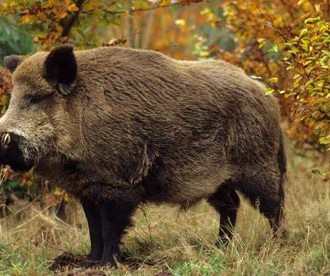


How to Draw a Boar
Please PAUSE the video after each step to draw at your own pace (scroll down to see the final boar drawing).
For the first few steps, don’t press down too hard with your pencil. Use light, smooth strokes to begin.
Step 1: Draw two circles as guides for the boar’s body. They don’t have to be perfect. They’re just guides. The circle on the left side should be slightly smaller than the one on the right, and you should draw them right next to each other.
Step 2: Draw another circle on the right side as a guide for the boar’s head. Draw this circle a bit smaller than the other two circles.
Step 3: Draw an angled arc on the right side of the head as a guide for the boar’s snout.
Step 4: Draw an angled line above the boar’s head similar to a triangle without a base as a guide for the ear.
Step 5: Draw two lines under the boar’s body (one below each circle) as guides for the legs.
Step 6: Draw a series of curved lines that connect the major shapes to form the boar’s body. Draw a small line on the left side as a guide for the tail.
That’s it for the initial sketch! From this point on, press harder with your pencil to get a more defined sketch.
Step 7: Draw the eye on the upper right side of the boar’s head. The shape of this animal’s eye resembles a football. Draw a circle inside and shade it in for the eyeball. Draw some lines surrounding the boar’s eye for extra detail.
Step 8: Use the initial arc as a guide to draw the snout. Make the line curve more as you darken it. Draw some quick, short strokes near the boar’s lower jaw to represent fur. Draw the nose as a curved line on the tip of the snout. Inside the nose, draw a circle and shade it in for the boar’s muzzle. Draw the mouth as a line under the nose. On the top part of the mouth, draw two narrow triangle-like shapes for the tusks.
Step 9: Use the initial shape as a guide to draw the ear. Boars have very furry ears, so draw around the guide using quick, short strokes to represent this. Use slightly longer strokes inside of the boar’s ear for the longer fur.
Step 10: Draw the rest of the boar’s head by using quick, short strokes for the fur as you go around the initial circle. Draw some lines inside the head too for extra detail.
Step 11: Using the line as a guide, draw the boar’s hind legs. Draw lightly at first. When you like what you have, go ahead and darken it. Draw the leg thicker on top and narrower at the bottom. Draw the two hoofed toes at the end and a smaller toe on the left side. The fourth toe is on the other side, so it’s not visible. Draw the boar’s leg on the other side the same way. Draw lightly at first to get the structure right, then darken it. Don’t forget the boar’s toes!
Step 12: Now use the other line as a guide to draw the boar’s front legs. The legs in front don’t angle forward like the hind legs. Use quick, short strokes at the base for the fur and draw the boar’s toes at the end. Use the same technique to draw the front leg on the other side.
Step 13: Use the initial lines as guides to draw the boar’s body. Boar fur consists of stiff bristles, so use quick, short strokes as you follow the guide lines. Draw the bristles longer at the top for the razorback look.
Step 14: Use the small line as a guide to draw the boar’s tail. Draw a few quick, short strokes at the end of the boar’s tail to represent fur.
Step 15 (optional): You can stop here for a sketchy look or erase as much as you can of the initial guide lines for a cleaner look. Don’t worry about erasing all of them. It’s okay to leave some behind. Also re-draw any final sketch lines that you may have accidentally erased.
Step 16 (optional): Add some shading to your boar drawing to give it more dimension and volume. Pick the direction of the light source when shading so that the shadows are consistent with it. Vary the pressure on your pencil to get different degrees of tonal value. Add a cast shadow underneath. This helps ground the boar so it doesn’t appear to be floating.
Step 17 (optional): You can add more value throughout your drawing for extra detail. It’s a good idea to use reference to be as accurate as possible. Remember to PAUSE the video any time you need help along the way.



